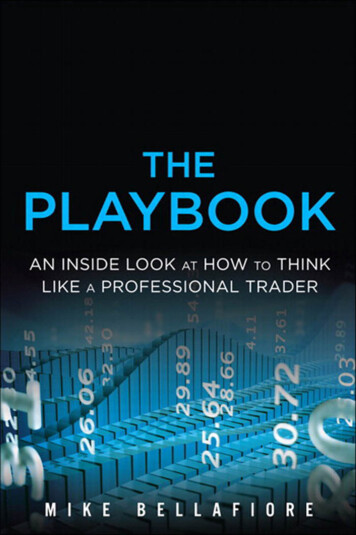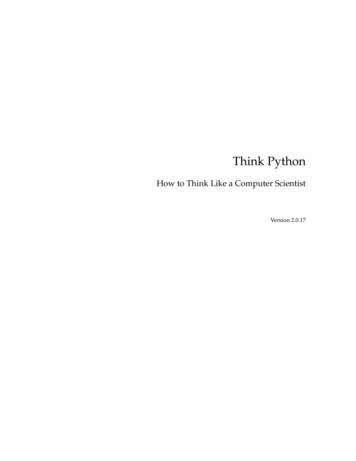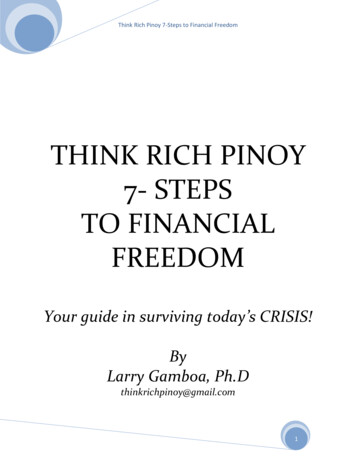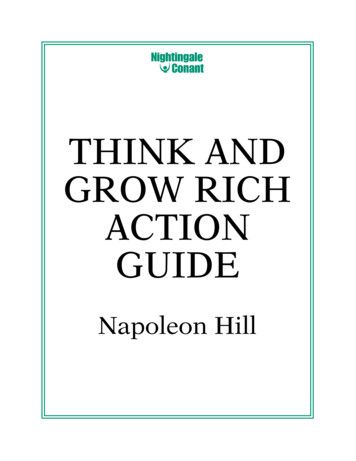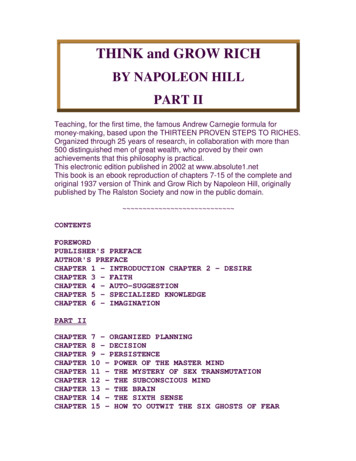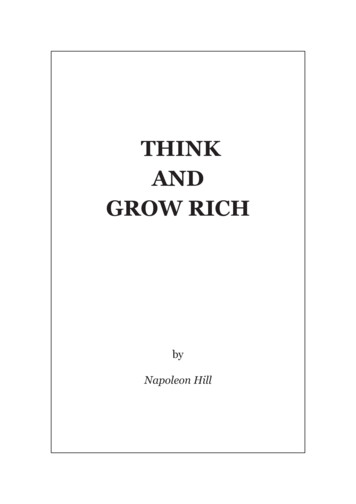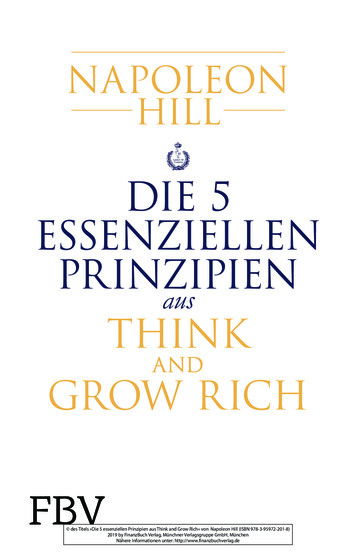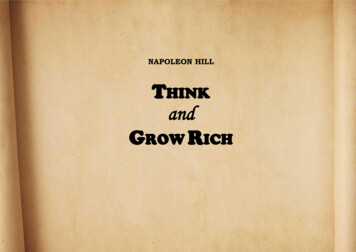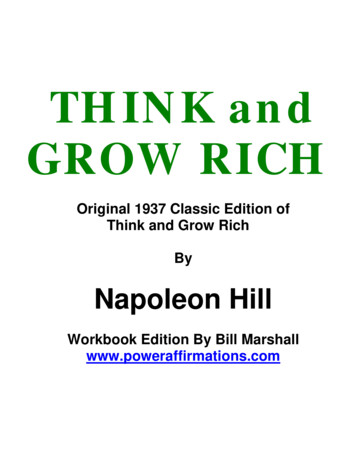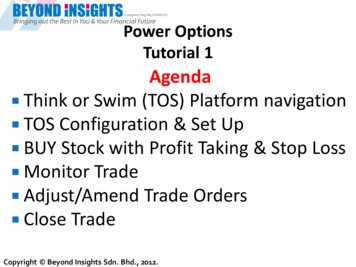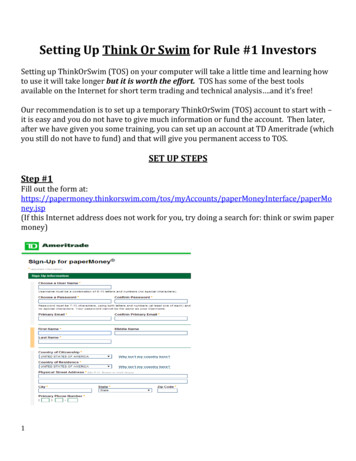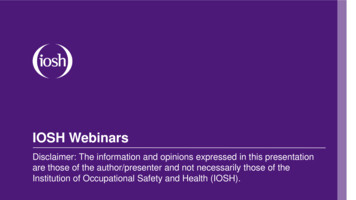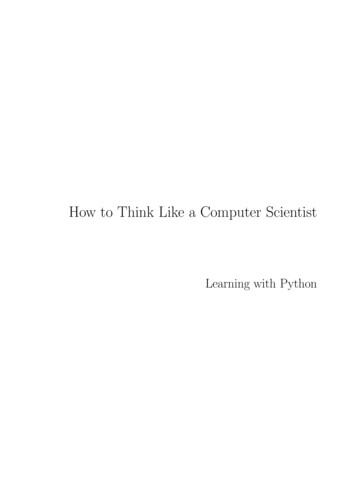
Transcription
How to Think Like a Computer ScientistLearning with Python
ii
How to Think Like a Computer ScientistLearning with PythonAllen DowneyJeffrey ElknerChris MeyersGreen Tea PressWellesley, Massachusetts
Copyright c 2002 Allen Downey, Jeffrey Elkner, and Chris Meyers.Edited by Shannon Turlington and Lisa Cutler. Cover design by Rebecca Gimenez.Printing history:April 2002: First edition.August 2008: Second printing.Green Tea Press1 Grove St.P.O. Box 812901Wellesley, MA 02482Permission is granted to copy, distribute, and/or modify this document under the termsof the GNU Free Documentation License, Version 1.1 or any later version published bythe Free Software Foundation; with the Invariant Sections being “Foreword,” “Preface,”and “Contributor List,” with no Front-Cover Texts, and with no Back-Cover Texts.A copy of the license is included in the appendix entitled “GNU Free DocumentationLicense.”The GNU Free Documentation License is available from www.gnu.org or by writing tothe Free Software Foundation, Inc., 59 Temple Place, Suite 330, Boston, MA 02111-1307,USA.The original form of this book is LATEX source code. Compiling this LATEX source hasthe effect of generating a device-independent representation of a textbook, which can beconverted to other formats and printed.The LATEX source for this book is available from http://www.thinkpython.comPublisher’s Cataloging-in-Publication (provided by Quality Books, Inc.)Downey, AllenHow to think like a computer scientist : learningwith Python / Allen Downey, Jeffrey Elkner, ChrisMeyers. – 1st ed.p. cm.Includes index.ISBN 0-9716775-0-6LCCN 20021006181. Python (Computer program language) I. Elkner,Jeffrey. II. Meyers, Chris. III. TitleQA76.73.P98D69 2002005.13’3QBI02-200031
ForewordBy David BeazleyAs an educator, researcher, and book author, I am delighted to see the completionof this book. Python is a fun and extremely easy-to-use programming languagethat has steadily gained in popularity over the last few years. Developed overten years ago by Guido van Rossum, Python’s simple syntax and overall feel islargely derived from ABC, a teaching language that was developed in the 1980’s.However, Python was also created to solve real problems and it borrows a widevariety of features from programming languages such as C , Java, Modula-3,and Scheme. Because of this, one of Python’s most remarkable features is itsbroad appeal to professional software developers, scientists, researchers, artists,and educators.Despite Python’s appeal to many different communities, you may still wonder“why Python?” or “why teach programming with Python?” Answering thesequestions is no simple task—especially when popular opinion is on the side ofmore masochistic alternatives such as C and Java. However, I think the mostdirect answer is that programming in Python is simply a lot of fun and moreproductive.When I teach computer science courses, I want to cover important concepts inaddition to making the material interesting and engaging to students. Unfortunately, there is a tendency for introductory programming courses to focus far toomuch attention on mathematical abstraction and for students to become frustrated with annoying problems related to low-level details of syntax, compilation,and the enforcement of seemingly arcane rules. Although such abstraction andformalism is important to professional software engineers and students who planto continue their study of computer science, taking such an approach in an introductory course mostly succeeds in making computer science boring. When I teacha course, I don’t want to have a room of uninspired students. I would much rathersee them trying to solve interesting problems by exploring different ideas, takingunconventional approaches, breaking the rules, and learning from their mistakes.
viForewordIn doing so, I don’t want to waste half of the semester trying to sort out obscuresyntax problems, unintelligible compiler error messages, or the several hundredways that a program might generate a general protection fault.One of the reasons why I like Python is that it provides a really nice balancebetween the practical and the conceptual. Since Python is interpreted, beginnerscan pick up the language and start doing neat things almost immediately without getting lost in the problems of compilation and linking. Furthermore, Pythoncomes with a large library of modules that can be used to do all sorts of tasks ranging from web-programming to graphics. Having such a practical focus is a greatway to engage students and it allows them to complete significant projects. However, Python can also serve as an excellent foundation for introducing importantcomputer science concepts. Since Python fully supports procedures and classes,students can be gradually introduced to topics such as procedural abstraction,data structures, and object-oriented programming—all of which are applicable tolater courses on Java or C . Python even borrows a number of features fromfunctional programming languages and can be used to introduce concepts thatwould be covered in more detail in courses on Scheme and Lisp.In reading Jeffrey’s preface, I am struck by his comments that Python allowedhim to see a “higher level of success and a lower level of frustration” and that hewas able to “move faster with better results.” Although these comments refer tohis introductory course, I sometimes use Python for these exact same reasons inadvanced graduate level computer science courses at the University of Chicago.In these courses, I am constantly faced with the daunting task of covering a lot ofdifficult course material in a blistering nine week quarter. Although it is certainlypossible for me to inflict a lot of pain and suffering by using a language like C ,I have often found this approach to be counterproductive—especially when thecourse is about a topic unrelated to just “programming.” I find that using Pythonallows me to better focus on the actual topic at hand while allowing students tocomplete substantial class projects.Although Python is still a young and evolving language, I believe that it has abright future in education. This book is an important step in that direction.David BeazleyUniversity of ChicagoAuthor of the Python Essential Reference
PrefaceBy Jeff ElknerThis book owes its existence to the collaboration made possible by the Internetand the free software movement. Its three authors—a college professor, a highschool teacher, and a professional programmer—have yet to meet face to face,but we have been able to work closely together and have been aided by manywonderful folks who have donated their time and energy to helping make thisbook better.We think this book is a testament to the benefits and future possibilities of thiskind of collaboration, the framework for which has been put in place by RichardStallman and the Free Software Foundation.How and why I came to use PythonIn 1999, the College Board’s Advanced Placement (AP) Computer Science examwas given in C for the first time. As in many high schools throughout thecountry, the decision to change languages had a direct impact on the computerscience curriculum at Yorktown High School in Arlington, Virginia, where I teach.Up to this point, Pascal was the language of instruction in both our first-year andAP courses. In keeping with past practice of giving students two years of exposureto the same language, we made the decision to switch to C in the first-yearcourse for the 1997-98 school year so that we would be in step with the CollegeBoard’s change for the AP course the following year.Two years later, I was convinced that C was a poor choice to use for introducingstudents to computer science. While it is certainly a very powerful programminglanguage, it is also an extremely difficult language to learn and teach. I foundmyself constantly fighting with C ’s difficult syntax and multiple ways of doingthings, and I was losing many students unnecessarily as a result. Convinced there
viiiPrefacehad to be a better language choice for our first-year class, I went looking for analternative to C .I needed a language that would run on the machines in our Linux lab as well as onthe Windows and Macintosh platforms most students have at home. I wanted it tobe free and available electronically, so that students could use it at home regardlessof their income. I wanted a language that was used by professional programmers,and one that had an active developer community around it. It had to supportboth procedural and object-oriented programming. And most importantly, it hadto be easy to learn and teach. When I investigated the choices with these goalsin mind, Python stood out as the best candidate for the job.I asked one of Yorktown’s talented students, Matt Ahrens, to give Python a try.In two months he not only learned the language but wrote an application calledpyTicket that enabled our staff to report technology problems via the Web. I knewthat Matt could not have finished an application of that scale in so short a timein C , and this accomplishment, combined with Matt’s positive assessment ofPython, suggested that Python was the solution I was looking for.Finding a textbookHaving decided to use Python in both of my introductory computer science classesthe following year, the most pressing problem was the lack of an available textbook.Free content came to the rescue. Earlier in the year, Richard Stallman had introduced me to Allen Downey. Both of us had written to Richard expressing aninterest in developing free educational content. Allen had already written a firstyear computer science textbook, How to Think Like a Computer Scientist. WhenI read this book, I knew immediately that I wanted to use it in my class. It wasthe clearest and most helpful computer science text I had seen. It emphasizedthe processes of thought involved in programming rather than the features of aparticular language. Reading it immediately made me a better teacher.How to Think Like a Computer Scientist was not just an excellent book, but ithad been released under a GNU public license, which meant it could be usedfreely and modified to meet the needs of its user. Once I decided to use Python,it occurred to me that I could translate Allen’s original Java version of the bookinto the new language. While I would not have been able to write a textbook onmy own, having Allen’s book to work from made it possible for me to do so, at thesame time demonstrating that the cooperative development model used so well insoftware could also work for educational content.Working on this book for the last two years has been rewarding for both mystudents and me, and my students played a big part in the process. Since I could
ixmake instant changes whenever someone found a spelling error or difficult passage,I encouraged them to look for mistakes in the book by giving them a bonus pointeach time they made a suggestion that resulted in a change in the text. This hadthe double benefit of encouraging them to read the text more carefully and ofgetting the text thoroughly reviewed by its most important critics, students usingit to learn computer science.For the second half of the book on object-oriented programming, I knew thatsomeone with more real programming experience than I had would be needed todo it right. The book sat in an unfinished state for the better part of a yearuntil the free software community once again provided the needed means for itscompletion.I received an email from Chris Meyers expressing interest in the book. Chris isa professional programmer who started teaching a programming course last yearusing Python at Lane Community College in Eugene, Oregon. The prospect ofteaching the course had led Chris to the book, and he started helping out with itimmediately. By the end of the school year he had created a companion projecton our website at http://www.ibiblio.org/obp called Python for Fun and wasworking with some of my most advanced students as a master teacher, guidingthem beyond where I could take them.Introducing programming with PythonThe process of translating and using How to Think Like a Computer Scientistfor the past two years has confirmed Python’s suitability for teaching beginningstudents. Python greatly simplifies programming examples and makes importantprogramming ideas easier to teach.The first example from the text illustrates this point. It is the traditional “hello,world” program, which in the C version of the book looks like this:#include iostream.h void main(){cout "Hello, world." endl;}in the Python version it becomes:print "Hello, World!"Even though this is a trivial example, the advantages of Python stand out. Yorktown’s Computer Science I course has no prerequisites, so many of the students
xPrefaceseeing this example are looking at their first program. Some of them are undoubtedly a little nervous, having heard that computer programming is difficult to learn.The C version has always forced me to choose between two unsatisfying options: either to explain #include, void main(), {, and }, and risk confusing orintimidating some of the students right at the start, or to tell them, “Just don’tworry about all of that stuff now; we will talk about it later,” and risk the samething. The educational objectives at this point in the course are to introducestudents to the idea of a programming language and to get them to write theirfirst program, thereby introducing them to the programming environment. ThePython program has exactly what is needed to do these things, and nothing more.Comparing the explanatory text of the program in each version of the book further illustrates what this means to the beginning student. There are thirteenparagraphs of explanation of “Hello, world!” in the C version; in the Pythonversion, there are only two. More importantly, the missing eleven paragraphs donot deal with the “big ideas” in computer programming but with the minutia ofC syntax. I found this same thing happening throughout the book. Wholeparagraphs simply disappear from the Python version of the text because Python’smuch clearer syntax renders them unnecessary.Using a very high-level language like Python allows a teacher to postpone talkingabout low-level details of the machine until students have the background thatthey need to better make sense of the details. It thus creates the ability to put“first things first” pedagogically. One of the best examples of this is the way inwhich Python handles variables. In C a variable is a name for a place thatholds a thing. Variables have to be declared with types at least in part becausethe size of the place to which they refer needs to be predetermined. Thus, theidea of a variable is bound up with the hardware of the machine. The powerfuland fundamental concept of a variable is already difficult enough for beginningstudents (in both computer science and algebra). Bytes and addresses do not helpthe matter. In Python a variable is a name that refers to a thing. This is a farmore intuitive concept for beginning students and is much closer to the meaningof “variable” that they learned in their math courses. I had much less difficultyteaching variables this year than I did in the past, and I spent less time helpingstudents with problems using them.Another example of how Python aids in the teaching and learning of programmingis in its syntax for functions. My students have always had a great deal of difficultyunderstanding functions. The main problem centers around the difference betweena function definition and a function call, and the related distinction between aparameter and an argument. Python comes to the rescue with syntax that isnothing short of beautiful. Function definitions begin with the keyword def, so Isimply tell my students, “When you define a function, begin with def, followed bythe name of the function that you are defining; when you call a function, simply
xicall (type) out its name.” Parameters go with definitions; arguments go with calls.There are no return types, parameter types, or reference and value parameters toget in the way, so I am now able to teach functions in less than half the time thatit previously took me, with better comprehension.Using Python has improved the effectiveness of our computer science program forall students. I see a higher general level of success and a lower level of frustrationthan I experienced during the two years I taught C . I move faster with betterresults. More students leave the course with the ability to create meaningfulprograms and with the positive attitude toward the experience of programmingthat this engenders.Building a communityI have received email from all over the globe from people using this book to learn orto teach programming. A user community has begun to emerge, and many peoplehave been contributing to the project by sending in materials for the companionwebsite at http://www.thinkpython.com.With the publication of the book in print form, I expect the growth in the usercommunity to continue and accelerate. The emergence of this user community andthe possibility it suggests for similar collaboration among educators have been themost exciting parts of working on this project for me. By working together, wecan increase the quality of materials available for our use and save valuable time.I invite you to join our community and look forward to hearing from you. Pleasewrite to the authors at feedback@thinkpython.com.Jeffrey ElknerYorktown High SchoolArlington, Virginia
xiiPreface
Contributor ListTo paraphrase the philosophy of the Free Software Foundation, this book is freelike free speech, but not necessarily free like free pizza. It came about because ofa collaboration that would not have been possible without the GNU Free Documentation License. So we thank the Free Software Foundation for developing thislicense and, of course, making it available to us.We also thank the more than 100 sharp-eyed and thoughtful readers who havesent us suggestions and corrections over the past few years. In the spirit of freesoftware, we decided to express our gratitude in the form of a contributor list.Unfortunately, this list is not complete, but we are doing our best to keep it upto date.If you have a chance to look through the list, you should realize that each personhere has spared you and all subsequent readers from the confusion of a technicalerror or a less-than-transparent explanation, just by sending us a note.Impossible as it may seem after so many corrections, there may still be errorsin this book. If you should stumble across one, please check the online versionof the book at http://thinkpython.com, which is the most up-to-date version.If the error has not been corrected, please take a minute to send us email atfeedback@thinkpython.com. If we make a change due to your suggestion, you willappear in the next version of the contributor list (unless you ask to be omitted).Thank you! Lloyd Hugh Allen sent in a correction to Section 8.4. Yvon Boulianne sent in a correction of a semantic error in Chapter 5. Fred Bremmer submitted a correction in Section 2.1. Jonah Cohen wrote the Perl scripts to convert the LaTeX source for thisbook into beautiful HTML.
xivContributor List Michael Conlon sent in a grammar correction in Chapter 2 and an improvement in style in Chapter 1, and he initiated discussion on the technicalaspects of interpreters. Benoit Girard sent in a correction to a humorous mistake in Section 5.6. Courtney Gleason and Katherine Smith wrote horsebet.py, which was usedas a case study in an earlier version of the book. Their program can now befound on the website. Lee Harr submitted more corrections than we have room to list here, andindeed he should be listed as one of the principal editors of the text. James Kaylin is a student using the text. He has submitted numerous corrections. David Kershaw fixed the broken catTwice function in Section 3.10. Eddie Lam has sent in numerous corrections to Chapters 1, 2, and 3. Healso fixed the Makefile so that it creates an index the first time it is run andhelped us set up a versioning scheme. Man-Yong Lee sent in a correction to the example code in Section 2.4. David Mayo pointed out that the word “unconsciously” in Chapter 1 neededto be changed to “subconsciously”. Chris McAloon sent in several corrections to Sections 3.9 and 3.10. Matthew J. Moelter has been a long-time contributor who sent in numerouscorrections and suggestions to the book. Simon Dicon Montford reported a missing function definition and severaltypos in Chapter 3. He also found errors in the increment function inChapter 13. John Ouzts corrected the definition of “return value” in Chapter 3. Kevin Parks sent in valuable comments and suggestions as to how to improvethe distribution of the book. David Pool sent in a typo in the glossary of Chapter 1, as well as kind wordsof encouragement. Michael Schmitt sent in a correction to the chapter on files and exceptions. Robin Shaw pointed out an error in Section 13.1, where the printTime function was used in an example without being defined.
xv Paul Sleigh found an error in Chapter 7 and a bug in Jonah Cohen’s Perlscript that generates HTML from LaTeX. Craig T. Snydal is testing the text in a course at Drew University. He hascontributed several valuable suggestions and corrections. Ian Thomas and his students are using the text in a programming course.They are the first ones to test the chapters in the latter half of the book,and they have made numerous corrections and suggestions. Keith Verheyden sent in a correction in Chapter 3. Peter Winstanley let us know about a longstanding error in our Latin inChapter 3. Chris Wrobel made corrections to the code in the chapter on file I/O andexceptions. Moshe Zadka has made invaluable contributions to this project. In additionto writing the first draft of the chapter on Dictionaries, he provided continualguidance in the early stages of the book. Christoph Zwerschke sent several corrections and pedagogic suggestions, andexplained the difference between gleich and selbe. James Mayer sent us a whole slew of spelling and typographical errors,including two in the contributor list. Hayden McAfee caught a potentially confusing inconsistency between twoexamples. Angel Arnal is part of an international team of translators working on theSpanish version of the text. He has also found several errors in the Englishversion. Tauhidul Hoque and Lex Berezhny created the illustrations in Chapter 1and improved many of the other illustrations. Dr. Michele Alzetta caught an error in Chapter 8 and sent some interestingpedagogic comments and suggestions about Fibonacci and Old Maid. Andy Mitchell caught a typo in Chapter 1 and a broken example in Chapter2. Kalin Harvey suggested a clarification in Chapter 7 and caught some typos. Christopher P. Smith caught several typos and is helping us prepare toupdate the book for Python 2.2.
xviContributor List David Hutchins caught a typo in the Foreword. Gregor Lingl is teaching Python at a high school in Vienna, Austria. Heis working on a German translation of the book, and he caught a couple ofbad errors in Chapter 5. Julie Peters caught a typo in the Preface. Florin Oprina sent in an improvement in makeTime, a correction inprintTime, and a nice typo. D. J. Webre suggested a clarification in Chapter 3. Ken found a fistful of errors in Chapters 8, 9 and 11. Ivo Wever caught a typo in Chapter 5 and suggested a clarification in Chapter 3. Curtis Yanko suggested a clarification in Chapter 2. Ben Logan sent in a number of typos and problems with translating thebook into HTML. Jason Armstrong saw the missing word in Chapter 2. Louis Cordier noticed a spot in Chapter 16 where the code didn’t match thetext. Brian Cain suggested several clarifications in Chapters 2 and 3. Rob Black sent in a passel of corrections, including some changes for Python2.2. Jean-Philippe Rey at Ecole Centrale Paris sent a number of patches, including some updates for Python 2.2 and other thoughtful improvements. Jason Mader at George Washington University made a number of usefulsuggestions and corrections. Jan Gundtofte-Bruun reminded us that “a error” is an error. Abel David and Alexis Dinno reminded us that the plural of “matrix” is“matrices”, not “matrixes”. This error was in the book for years, but tworeaders with the same initials reported it on the same day. Weird. Charles Thayer encouraged us to get rid of the semi-colons we had put atthe ends of some statements and to clean up our use of “argument” and“parameter”.
xvii Roger Sperberg pointed out a twisted piece of logic in Chapter 3. Sam Bull pointed out a confusing paragraph in Chapter 2. Andrew Cheung pointed out two instances of “use before def.” Hans Batra found an error in Chapter 16. Chris Seberino suggested some improvements in the Preface. Yuri Takhteyev pointed out a problem with single and double quotes.
xviiiContributor List
ContentsForewordvPrefaceviiContributor Listxiii1 The way of the program11.1The Python programming language . . . . . . . . . . . . . . . . .11.2What is a program? . . . . . . . . . . . . . . . . . . . . . . . . .31.3What is debugging?. . . . . . . . . . . . . . . . . . . . . . . . .41.4Formal and natural languages . . . . . . . . . . . . . . . . . . . .61.5The first program . . . . . . . . . . . . . . . . . . . . . . . . . . .81.6Glossary . . . . . . . . . . . . . . . . . . . . . . . . . . . . . . . .82 Variables, expressions and statements112.1Values and types . . . . . . . . . . . . . . . . . . . . . . . . . . .112.2Variables . . . . . . . . . . . . . . . . . . . . . . . . . . . . . . . .122.3Variable names and keywords . . . . . . . . . . . . . . . . . . . .132.4Statements . . . . . . . . . . . . . . . . . . . . . . . . . . . . . .152.5Evaluating expressions . . . . . . . . . . . . . . . . . . . . . . . .162.6Operators and operands . . . . . . . . . . . . . . . . . . . . . . .17
xxContents2.7Order of operations . . . . . . . . . . . . . . . . . . . . . . . . . .172.8Operations on strings . . . . . . . . . . . . . . . . . . . . . . . . .182.9Composition . . . . . . . . . . . . . . . . . . . . . . . . . . . . . .192.10Comments . . . . . . . . . . . . . . . . . . . . . . . . . . . . . . .192.11Glossary . . . . . . . . . . . . . . . . . . . . . . . . . . . . . . . .203 Functions233.1Function calls . . . . . . . . . . . . . . . . . . . . . . . . . . . . .233.2Type conversion . . . . . . . . . . . . . . . . . . . . . . . . . . . .243.3Type coercion . . . . . . . . . . . . . . . . . . . . . . . . . . . . .243.4Math functions . . . . . . . . . . . . . . . . . . . . . . . . . . . .253.5Composition . . . . . . . . . . . . . . . . . . . . . . . . . . . . . .263.6Adding new functions . . . . . . . . . . . . . . . . . . . . . . . .263.7Definitions and use . . . . . . . . . . . . . . . . . . . . . . . . . .293.8Flow of execution . . . . . . . . . . . . . . . . . . . . . . . . . . .293.9Parameters and arguments . . . . . . . . . . . . . . . . . . . . . .303.10Variables and parameters are local . . . . . . . . . . . . . . . . .313.11Stack diagrams . . . . . . . . . . . . . . . . . . . . . . . . . . . .323.12Functions with results . . . . . . . . . . . . . . . . . . . . . . . .333.13Glossary . . . . . . . . . . . . . . . . . . . . . . . . . . . . . . . .344 Conditionals and recursion374.1The modulus operator . . . . . . . . . . . . . . . . . . . . . . . .374.2Boolean expressions. . . . . . . . . . . . . . . . . . . . . . . . .374.3Logical operators . . . . . . . . . . . . . . . . . . . . . . . . . . .384.4Conditional execution . . . . . . . . . . . . . . . . . . . . . . . .394.5Alternative execution . . . . . . . . . . . . . . . . . . . . . . . . .394.6Chained conditionals . . . . . . . . . . . . . . . . . . . . . . . . .40
Contentsxxi4.7Nested conditionals . . . . . . . . . . . . . . . . . . . . . . . . . .414.8The return statement . . . . . . . . . . . . . . . . . . . . . . . .424.9Recursion . . . . . . . . . . . . . . . . . . . . . . . . . . . . . . .424.10Stack diagrams for recursive functions . . . . . . . . . . . . . . .444.11Infinite recursion . . . . . . . . . . . . . . . . . . . . . . . . . . .454.12Keyboard input . . . . . . . . . . . . . . . . . . . . . . . . . . . .454.13Glossary . . . . . . . . . . . . . . . . . . . . . . . . . . . . . . . .465 Fruitful functions495.1Return values . . . . . . . . . . . . . . . . . . . . . . . . . . . . .495.2Program development . . . . . . . . . . . . . . . . . . . . . . . .505.3Composition . . . . . . . . . . . . . . . . . . . . . . . . . . . . . .535.4Boolean functions . . . . . . . . . . . . . . . . . . . . . . . . . . .545.5More recursion . . . . . . . . . . . . . . . . . . . . . . . . . . . .555.6Leap of faith. . . . . . . . . . . . . . . . . . . . . . . . . . . . .575.7One more example . . . . . . . . . . . . . . . . . . . . . . . . . .585.8Checking types . . . . . . . . . . . . . . . . . . . . . . . . . . . .585.9Glossary . . . . . . . . . . . . . . . . . . . . . . . . . . . . . . . .606 Iteration616.1Multiple assignment . . . . . . . . . . . . . . . . . . . . . . . . .616.2The while statement . . . . . . . . . . . . . . . . . . . . . . . . .626.3Tables . . . . . . . . . . . . . . . . . . . . . . . . . . . . . . . . .646.4Two-dimensional tables . . . . . . . . . . . . . . . . . . . . . . .666.5Encapsulation and generalization . . . . . . . . . . . . . . . . . .676.6More encapsulation . . . . . . . . . . . . . . . . . . . . . . . . . .686.7Local variables . . . . . . . . . . . . . . . . . . . . . . . . . . . .696.8More generalization . . . . . . . . . . . . . . . . . . . . . . . . . .706.9Functions . . . . . . . . . . . . . . . . . . . . . . . . . . . . . . .716.10Glossary . . . . . . . . . . . . . . .
Python is a fun and extremely easy-to-use programming language that has steadily gained in popularity over the last few years. Developed over ten years ago by Guido van Rossum, Python’s simple syntax and overall feel is largely derived from A
